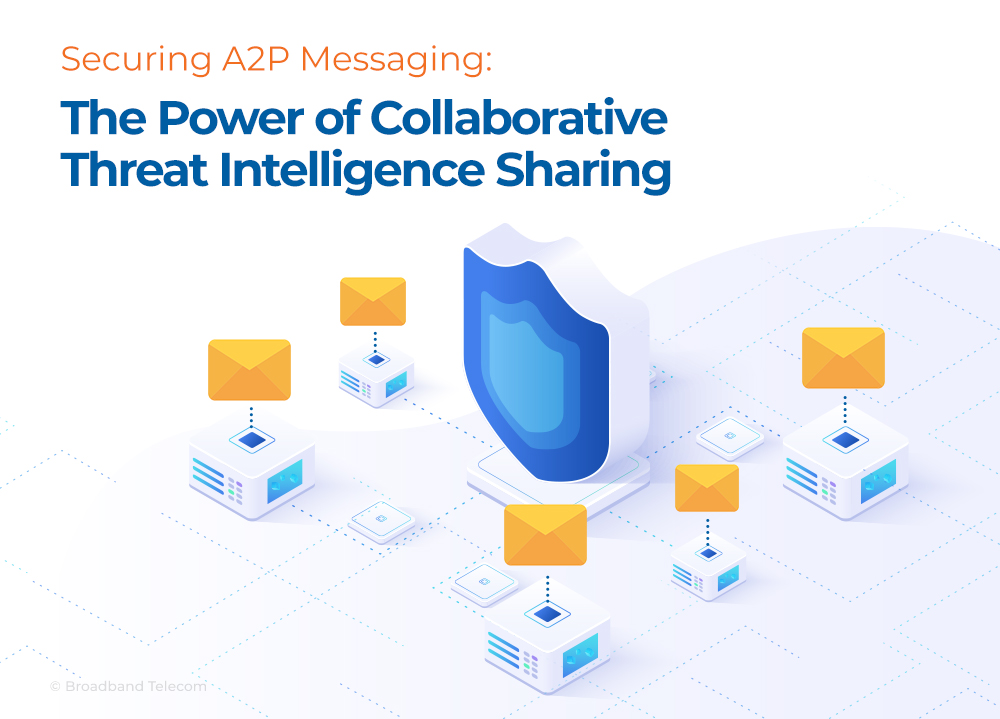Collaborative Threat Intelligence Sharing in A2P Messaging: Strengthening Industry Defenses

In the growing era of the communication technology landscape, A2P messaging has emerged as a critical channel for businesses to engage with their customers.
A2P messaging facilitates the delivery of essential notifications, alerts, and promotional messages from applications to individuals, spanning various industries, including banking, healthcare, retail, and more.
However, alongside the convenience and efficiency offered by A2P messaging, there exists a growing concern surrounding security threats that jeopardize the integrity of this communication channel.
What is Collaborative Threat Intelligence Sharing?
Collaborative threat intelligence sharing entails exchanging actionable insights and intelligence among industry stakeholders to identify, mitigate, and prevent security threats in A2P messaging. Unlike traditional security measures that operate in isolation, collaborative threat intelligence sharing emphasizes the collective strength of the ecosystem. By sharing real-time threat data, indicators of compromise, and best practices, organizations can enhance their threat detection capabilities and fortify their defenses against malicious actors.
Importance of Collaboration in Threat Intelligence Sharing
These are a few essential reasons why collaboration in threat intelligence sharing should be considered important:
Collective Strength
Collaboration harnesses the collective resources, expertise, and insights of industry stakeholders to strengthen the resilience of the A2P messaging ecosystem against cyber threats.
Diverse Perspectives
By fostering collaboration among mobile network operators, messaging aggregators, regulatory bodies, and cybersecurity firms, organizations can leverage diverse perspectives and insights to stay ahead of emerging threats.
Resource Pooling
Collaboration enables organizations to pool resources, share intelligence, and coordinate response efforts, amplifying their collective ability to detect, mitigate, and prevent security threats in A2P messaging.
Timely Response
Collaborative threat intelligence sharing facilitates timely dissemination of threat data, indicators of compromise, and best practices, enabling organizations to respond proactively to evolving cyber threats.
Industry Resilience
Through collaboration, industry stakeholders can collectively enhance their security posture, mitigate risks, and preserve trust in the digital ecosystem, safeguarding the integrity of A2P messaging communications.
Industry Challenges in A2P Messaging Security
A2P messaging faces diverse security threats, ranging from traditional cyberattacks to sophisticated social engineering tactics.
Common threats include phishing attacks, where malicious actors exploit A2P messaging channels to deliver messages impersonating legitimate entities, aiming to deceive recipients into divulging sensitive information or downloading malware-infected attachments.
The ramifications of security breaches in A2P messaging can be far-reaching, encompassing financial losses, reputational damage, and regulatory scrutiny.
Security breaches can result in financial losses from fraudulent transactions, unauthorized access to sensitive accounts, and regulatory penalties for non-compliance with industry standards and regulations. Security breaches also tarnish the reputation of businesses, eroding trust and satisfaction among customers and stakeholders.
That calls for security measures, which are as follows:
Proactive Measures
Implementing Robust Authentication Mechanisms
Deploying multi-factor authentication (MFA) and strong password policies can help avert unauthorized access attempts and mitigate the risk of account takeovers.
Enhancing Threat Detection Capabilities
Leveraging advanced threat detection technologies, such as anomaly detection and behavioral analytics enables organizations to identify and respond to security threats in real time.
Educating Users
Educating users about common security threats, phishing awareness, and safe browsing practices empowers them to recognize and mitigate potential risks associated with A2P messaging.
Collaborative Threat Intelligence Sharing
Engaging in collaborative threat intelligence sharing initiatives enables organizations to stay abreast of emerging threats and adopt proactive measures to strengthen the resilience of the A2P messaging ecosystem.
Technological Solutions for Threat Intelligence Sharing
Leveraging technological solutions is paramount to facilitate effective threat intelligence sharing. Let’s dive into three critical technical approaches:
Data Sharing Platforms and Tools
Data-sharing platforms and tools facilitate threat intelligence exchange among industry stakeholders. These platforms provide a centralized repository for storing and sharing threat data, enabling organizations to collaborate seamlessly.
Advanced features such as real-time updates, data normalization, and customizable alerts enhance the efficiency and effectiveness of threat intelligence sharing efforts.
Threat Feeds and Information-Sharing Protocols
Threat feeds and information-sharing protocols are essential for disseminating timely threat intelligence to relevant parties. Threat feeds aggregate data from various sources, including security researchers, vendors, and open-source communities, providing actionable insights into emerging threats and vulnerabilities.
Information-sharing protocols, such as STIX/TAXII, facilitate the standardized exchange of threat intelligence data, ensuring interoperability and consistency across disparate systems.
Role of Automation and Machine Learning
Automation and machine learning technologies play a pivotal role in augmenting the efficacy of threat intelligence-sharing initiatives. Automated systems can ingest, analyze, and disseminate large volumes of threat data at scale, enabling rapid detection and response. Machine learning algorithms enhance the accuracy and efficiency of threat intelligence analysis by identifying patterns, anomalies, and correlations within vast datasets. Automation streamlines routine tasks such as data enrichment, normalization, and incident response, freeing human resources to focus on strategic security initiatives.
Best Practices for Collaborative Threat Intelligence Sharing
Effective collaboration is essential for maximizing the impact of threat intelligence-sharing efforts. Here are three best practices to foster collaboration and enhance the effectiveness of threat intelligence sharing:
Establishing Trust Relationships
Building trust relationships among participating organizations is critical to fostering open and transparent communication. Establishing clear guidelines, mutual agreements, and trust frameworks ensures that sensitive threat intelligence is shared securely and responsibly.
Anonymization and Protection of Sensitive Data
Anonymization and protection of sensitive data are paramount to safeguarding privacy and confidentiality in threat intelligence sharing initiatives. Implementing robust anonymization techniques and data protection measures ensures that personally identifiable information (PII) and sensitive business data are anonymized or encrypted before sharing.
Adherence to Data Privacy Regulations
Compliance with data privacy regulations, such as GDPR and CCPA, is essential when sharing threat intelligence data across organizational boundaries. Organizations must ensure their threat intelligence sharing practices adhere to applicable legal and regulatory requirements regarding data privacy, consent, and transparency.
Collaborate with Broadband Telecom to Strengthening Industry Defenses in A2P Messaging
The future of A2P messaging is teeming with innovation and potential, driven by advancements in AI and other emerging technologies. From hyper-personalized communication experiences to voice-enabled interactions, predictive engagement, enhanced security, and IoT integration, businesses have many opportunities to elevate their A2P messaging strategies.
At Broadband Telecom, we are committed to empowering businesses to seize these opportunities and strengthen their A2P messaging defenses. With our extensive experience and exceptional coverage in international messaging and voice termination, we provide a robust platform for global A2P messaging and wholesale voice traffic termination needs across the globe.
Ready to revolutionize your A2P messaging strategy and leverage the power of AI for enhanced engagement? Connect with us today to explore how we can help you drive business growth in the dynamic world of broadband telecom, where seamless communication meets cutting-edge technology.

Niyati Madhvani
A flamboyant, hazel-eyed lady, Niyati loves learning new dynamics around marketing and sales. She specializes in building relationships with people through her conversational and writing skills. When she is not thinking about the next content campaign, you'll find her traveling and dwelling in books!
